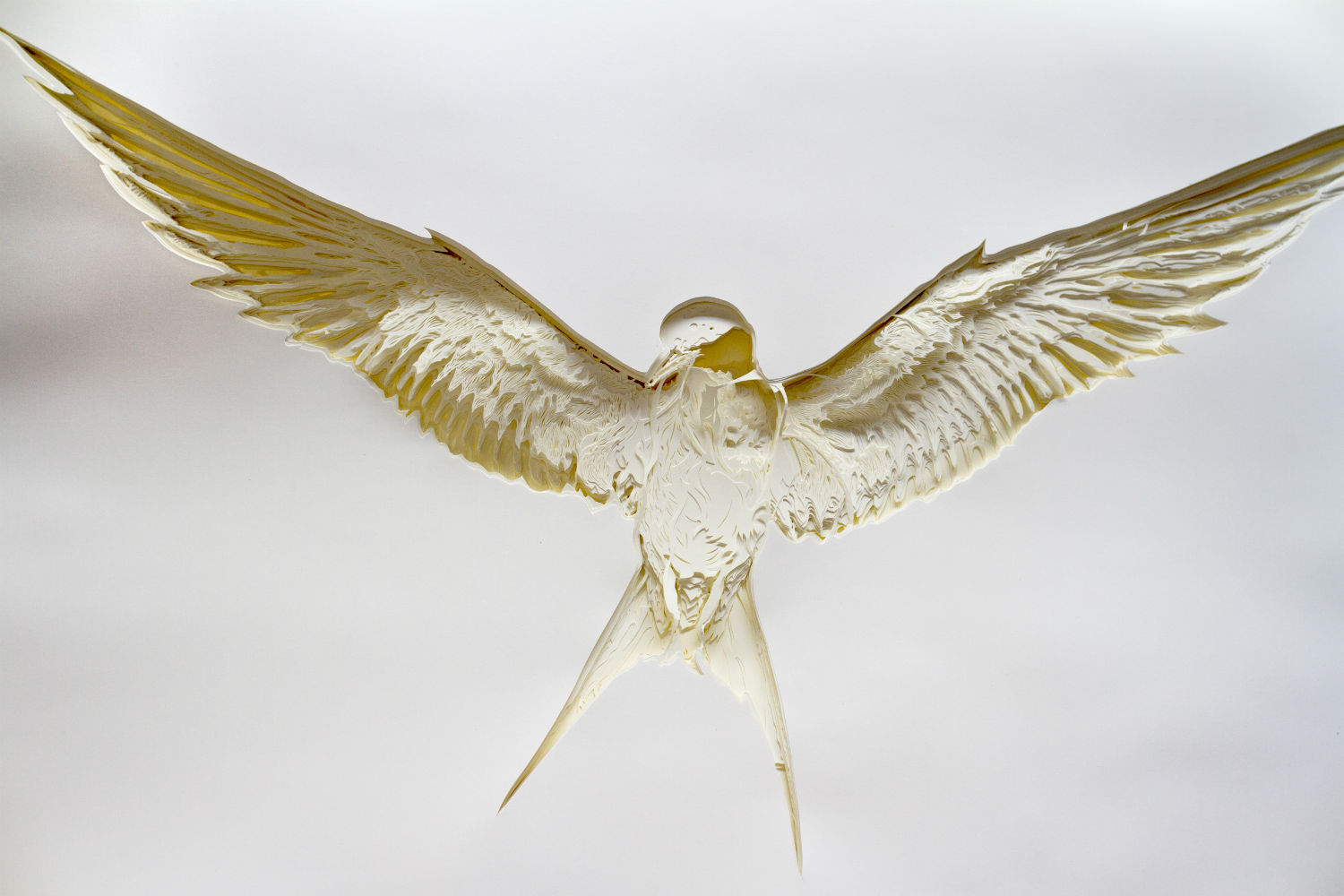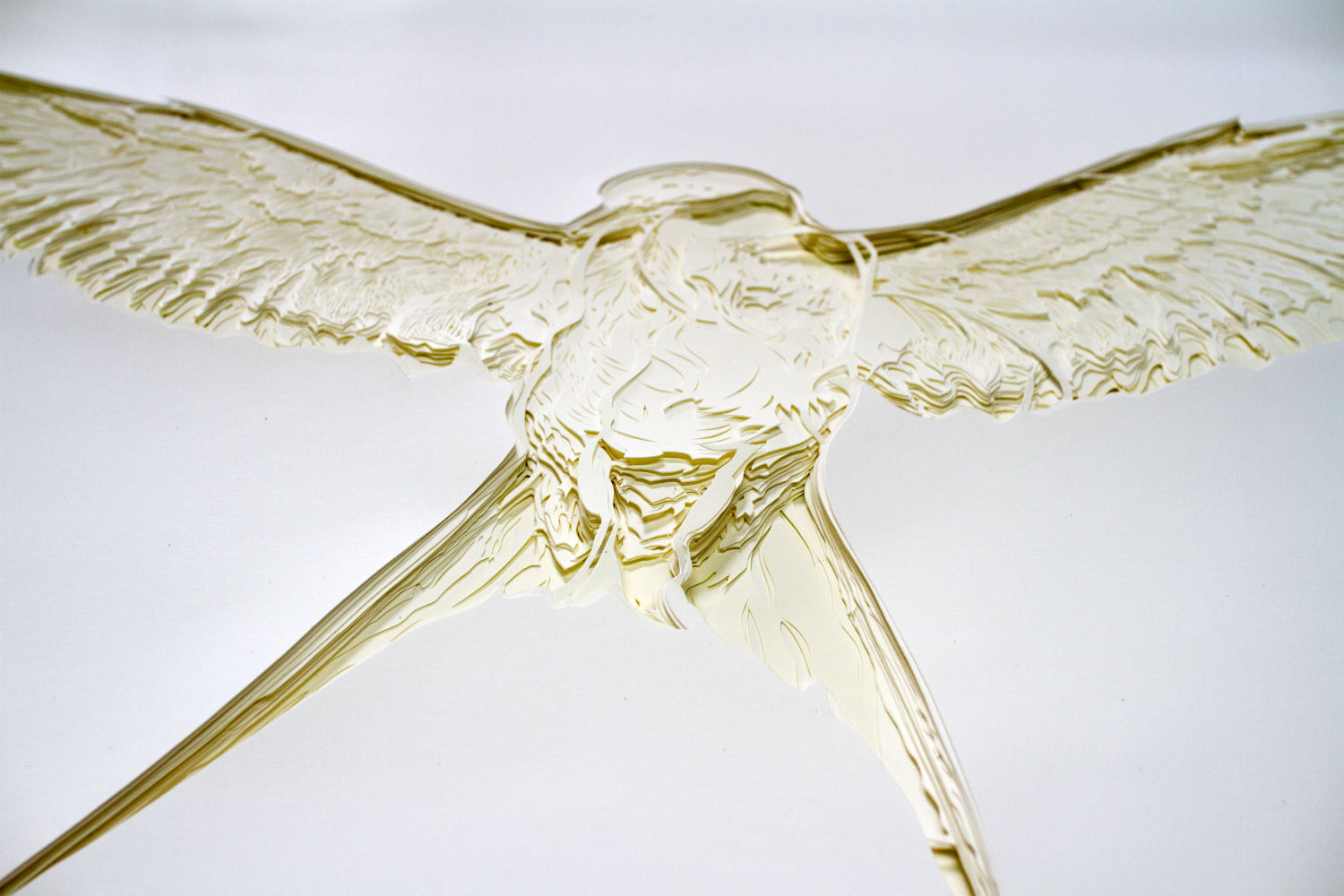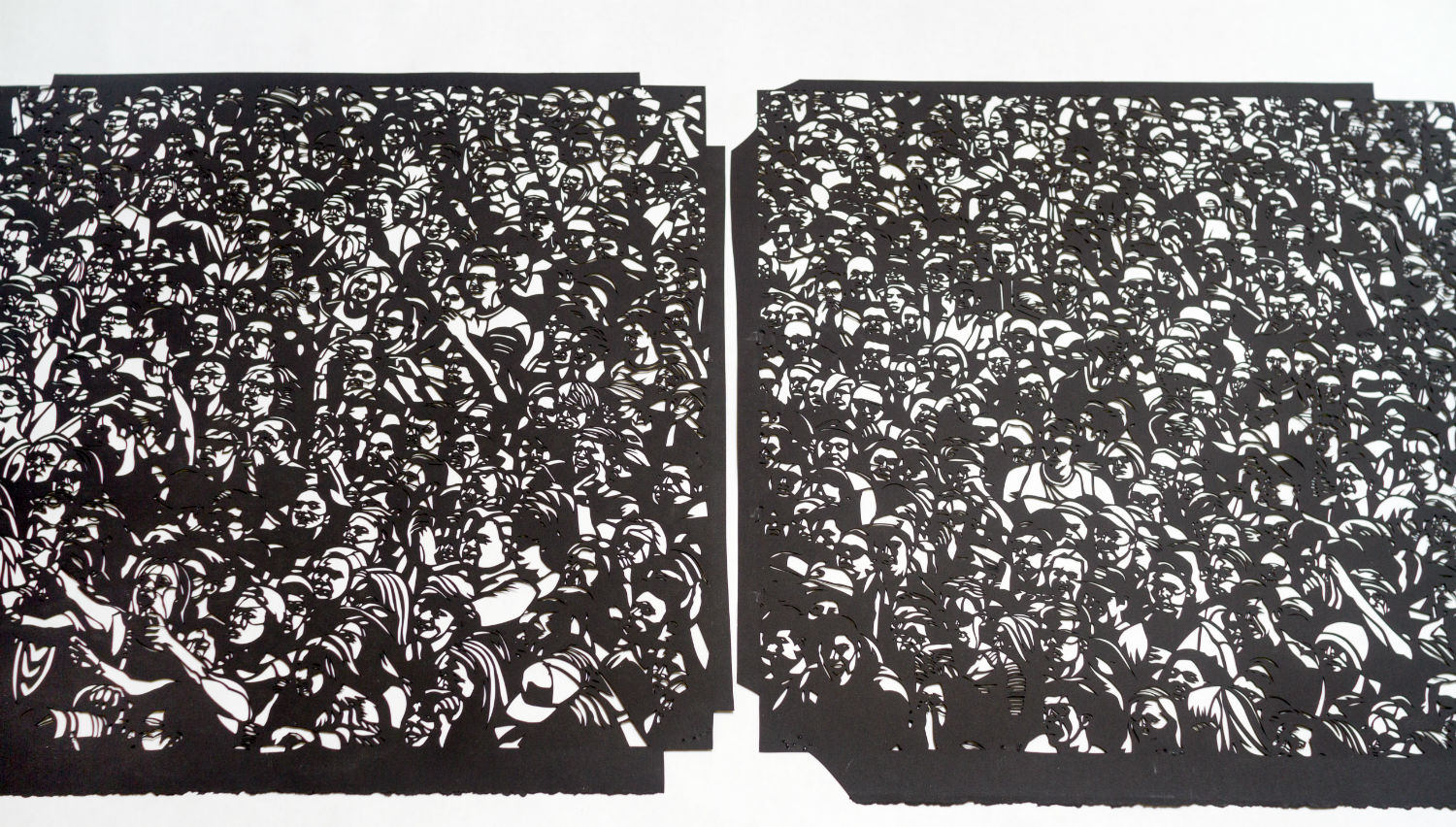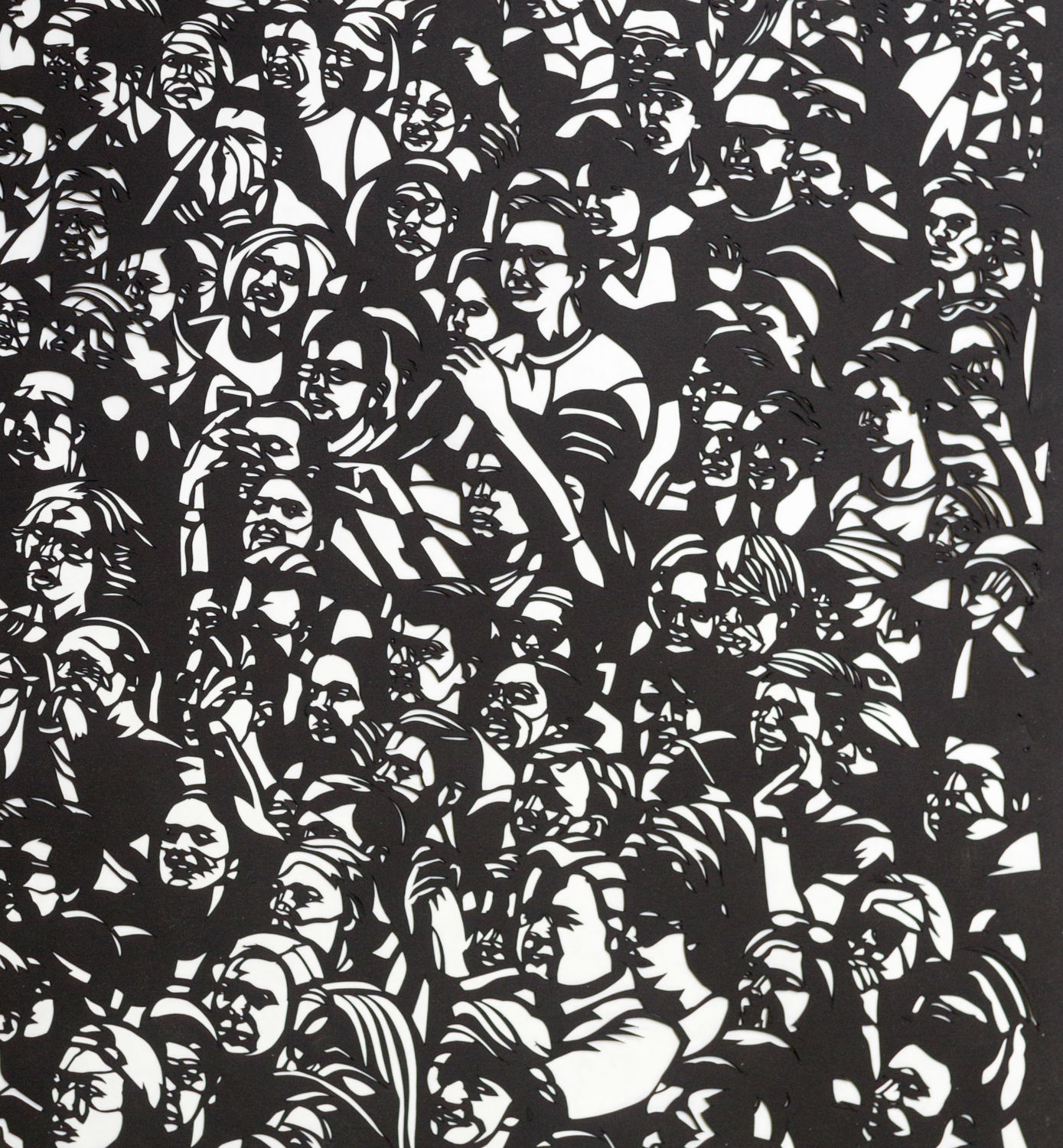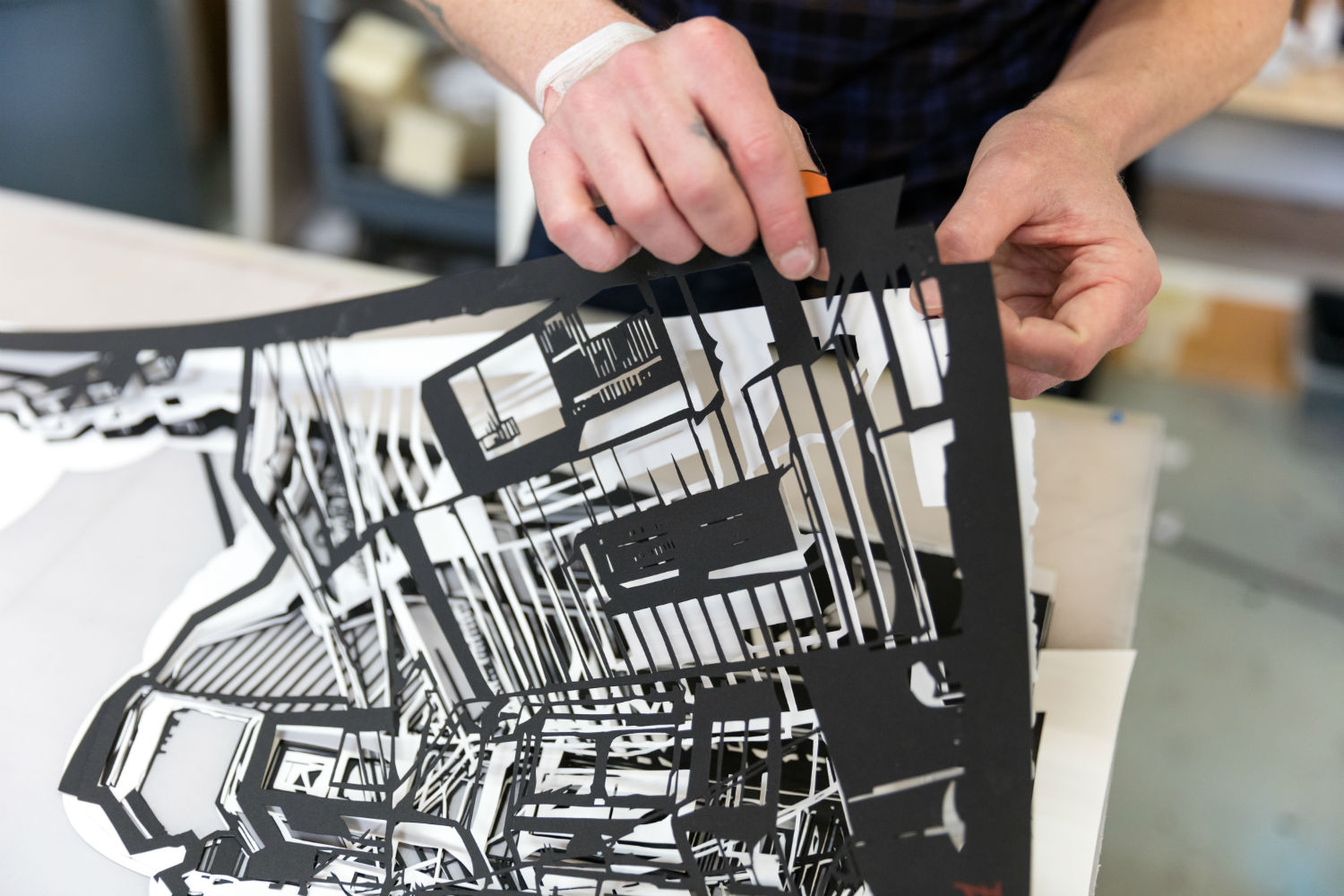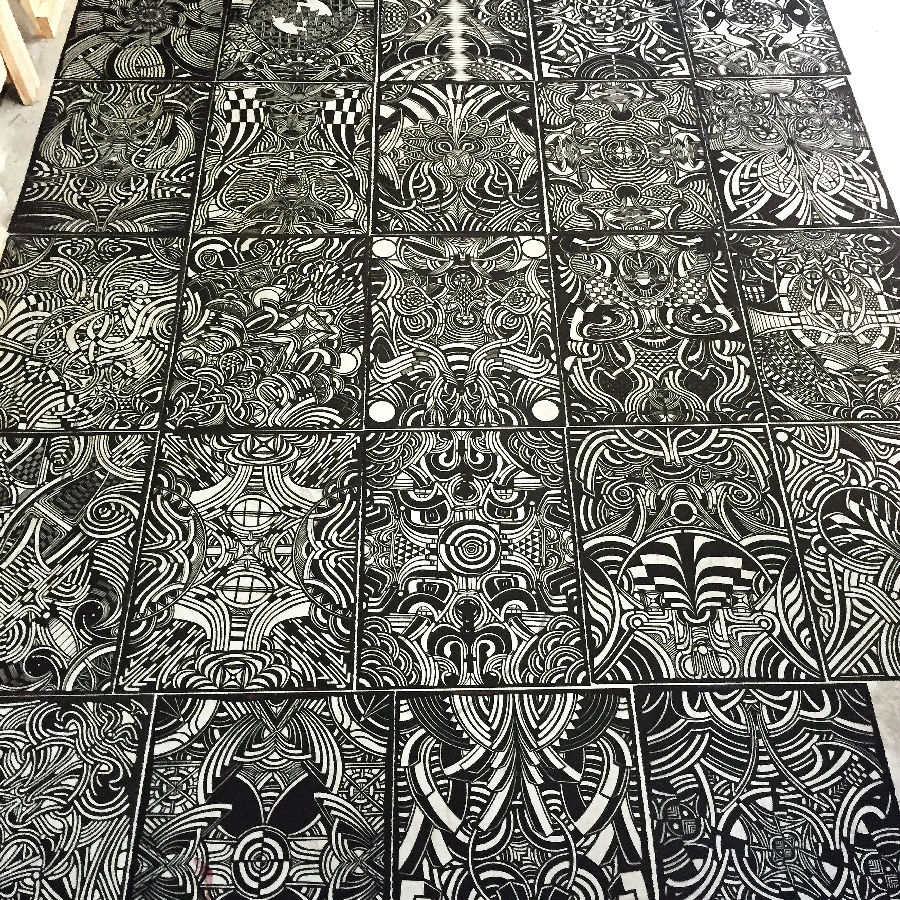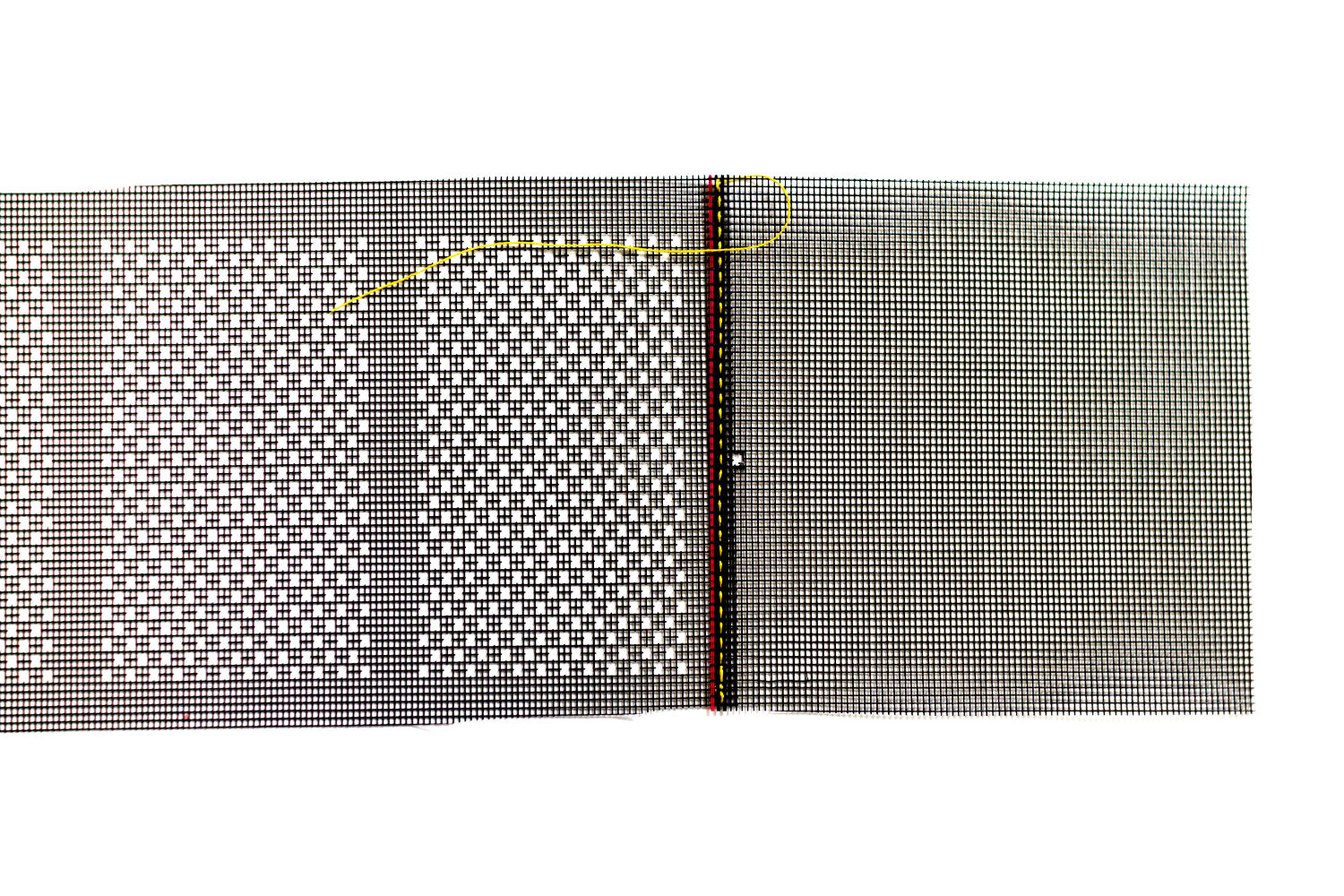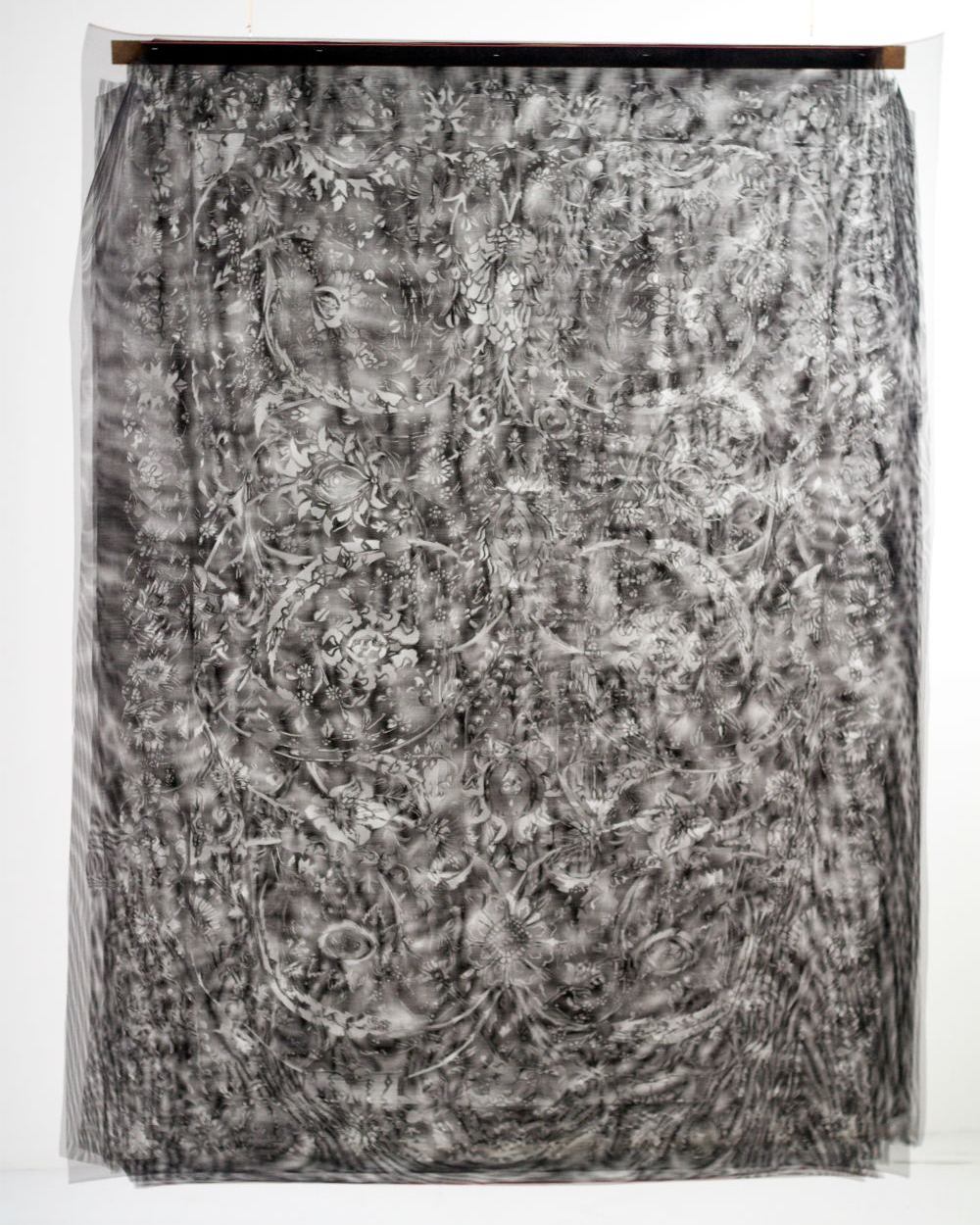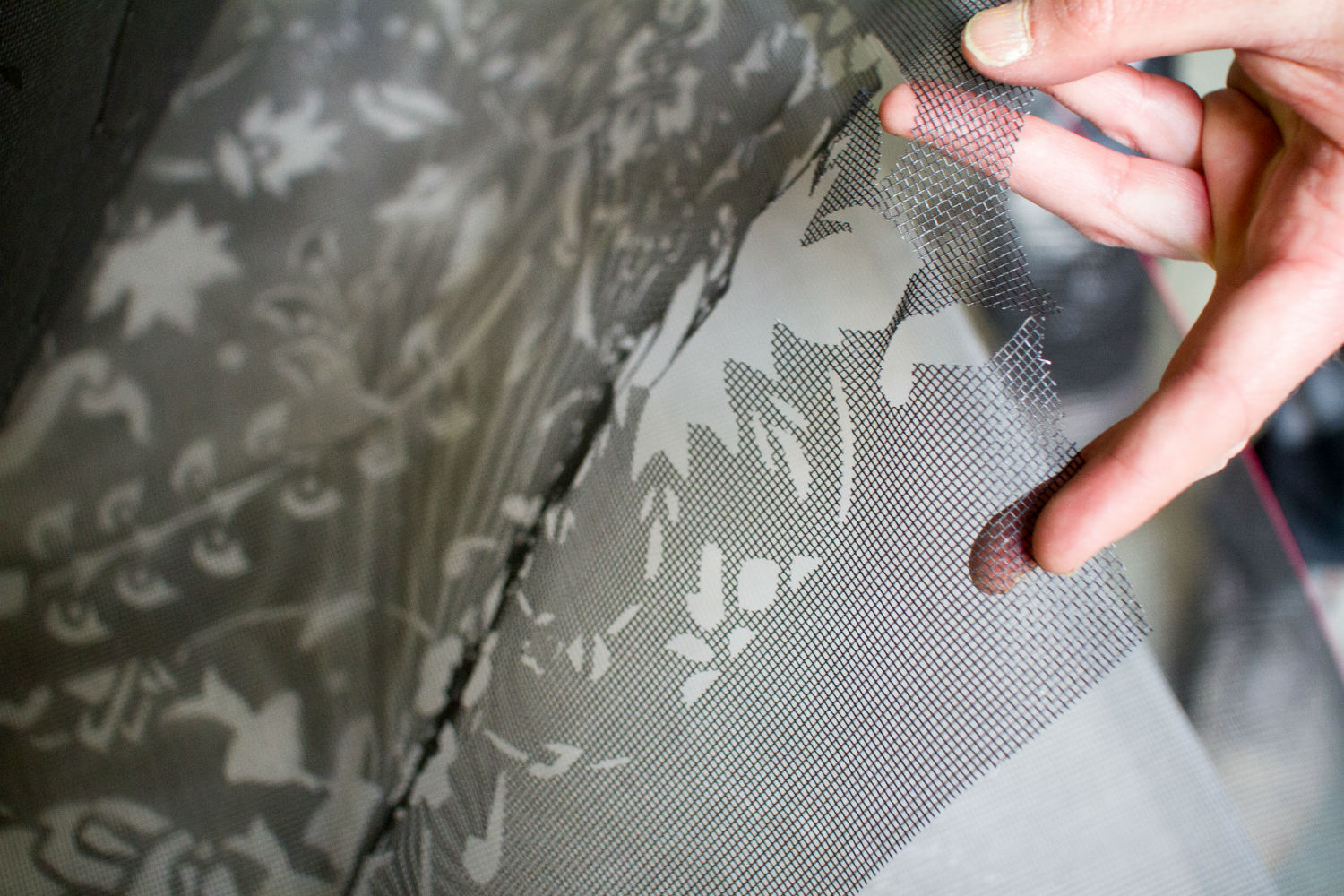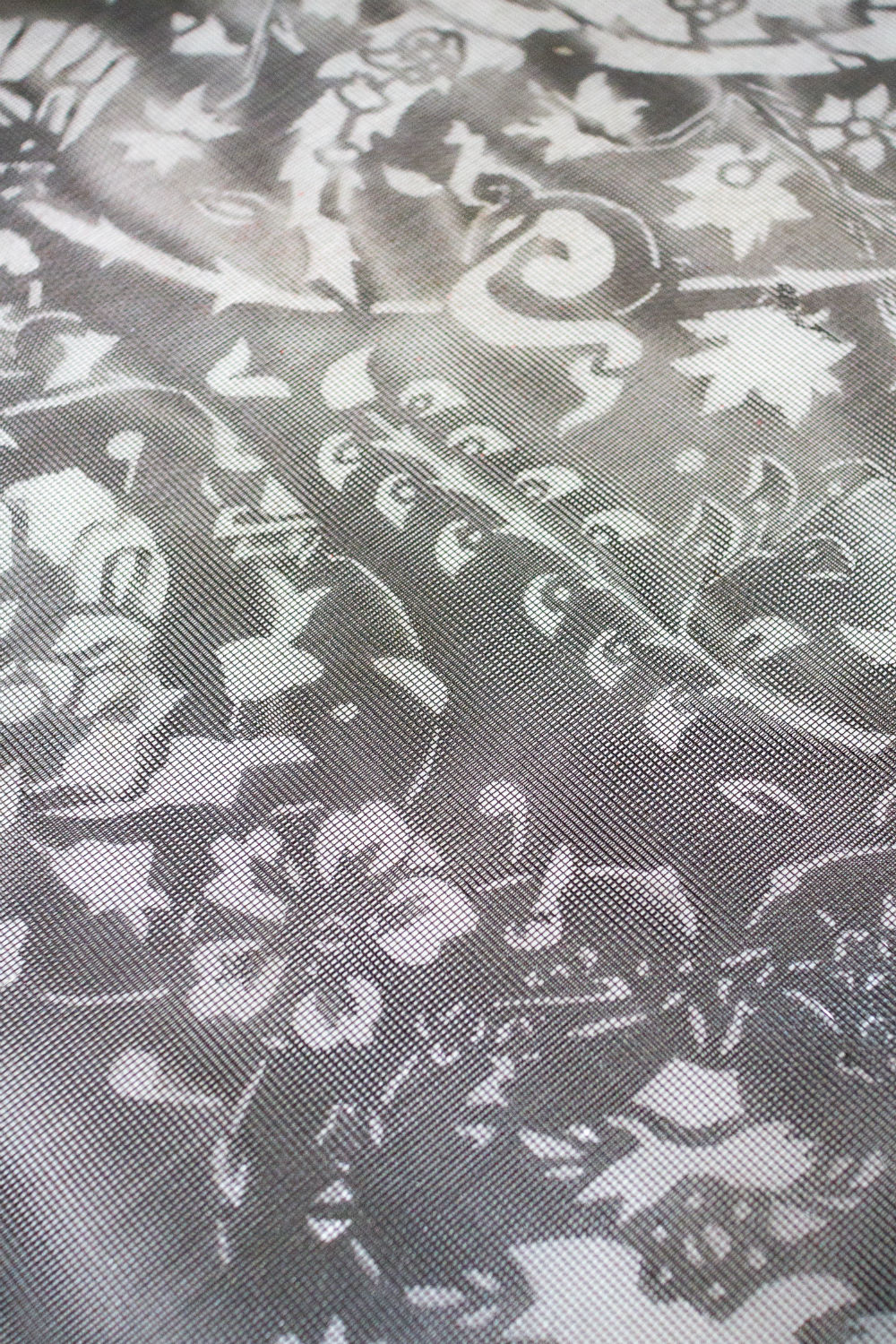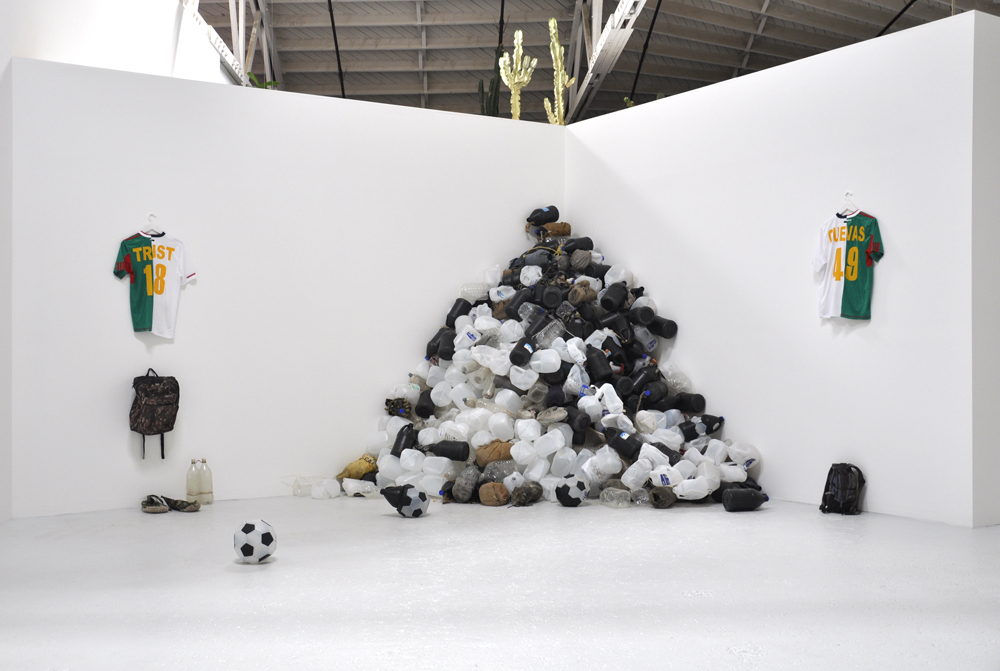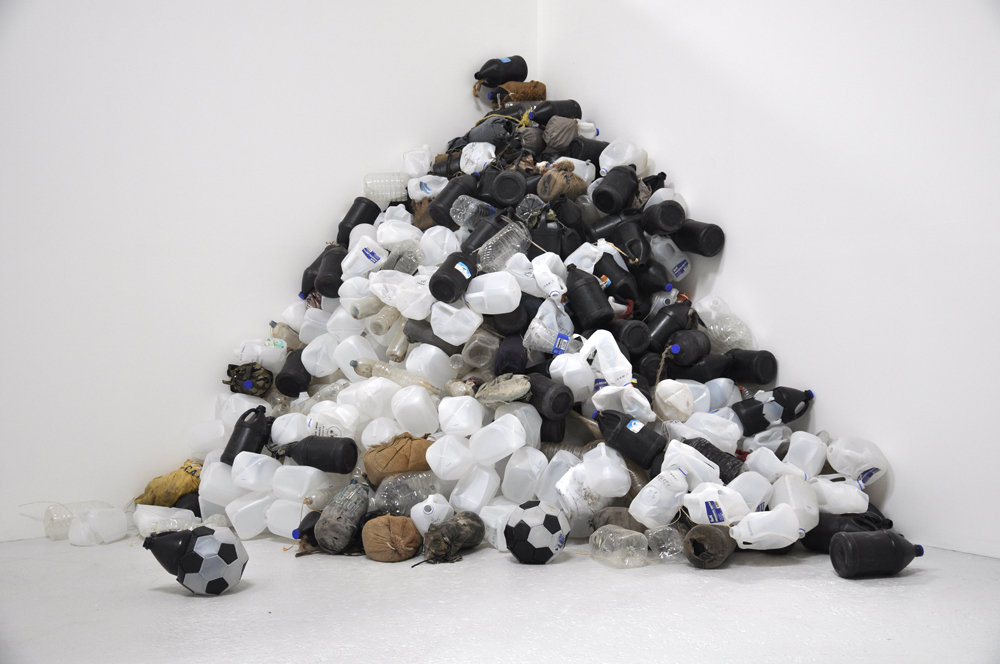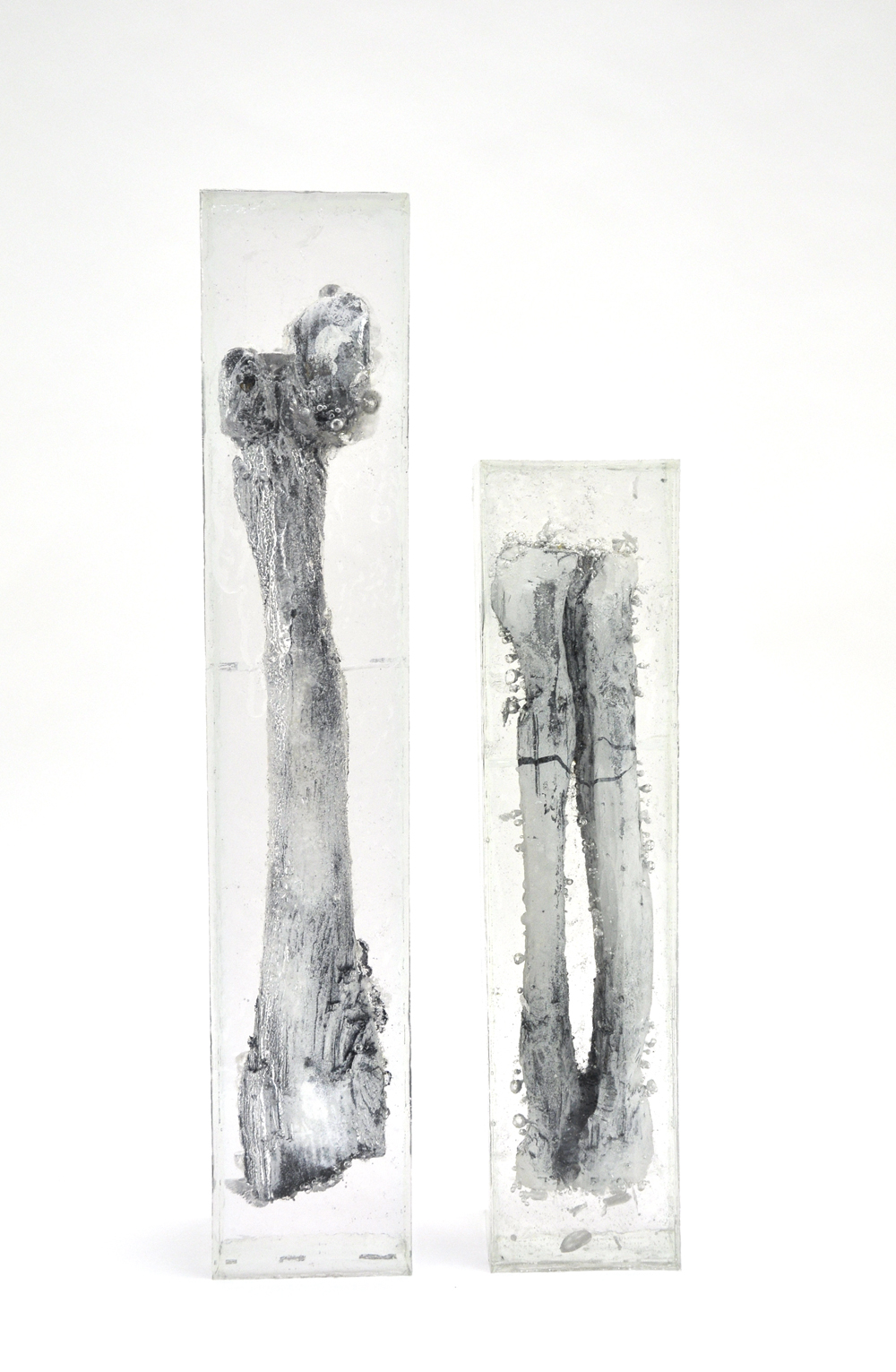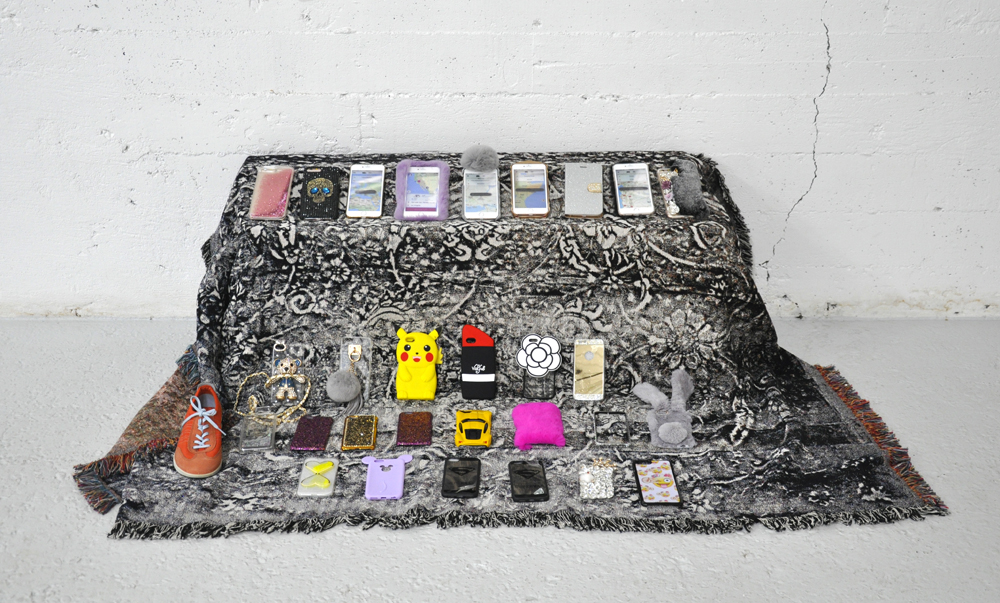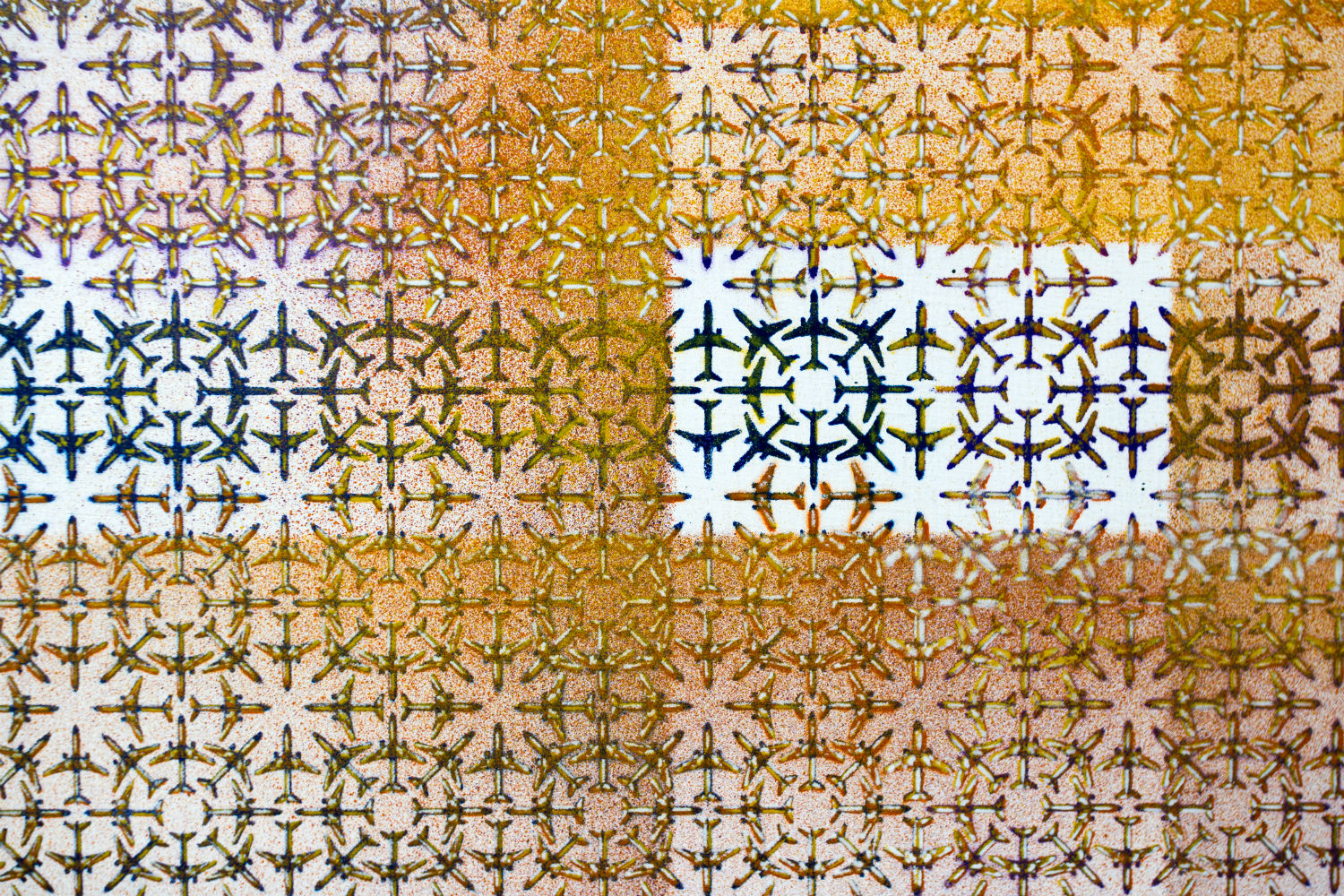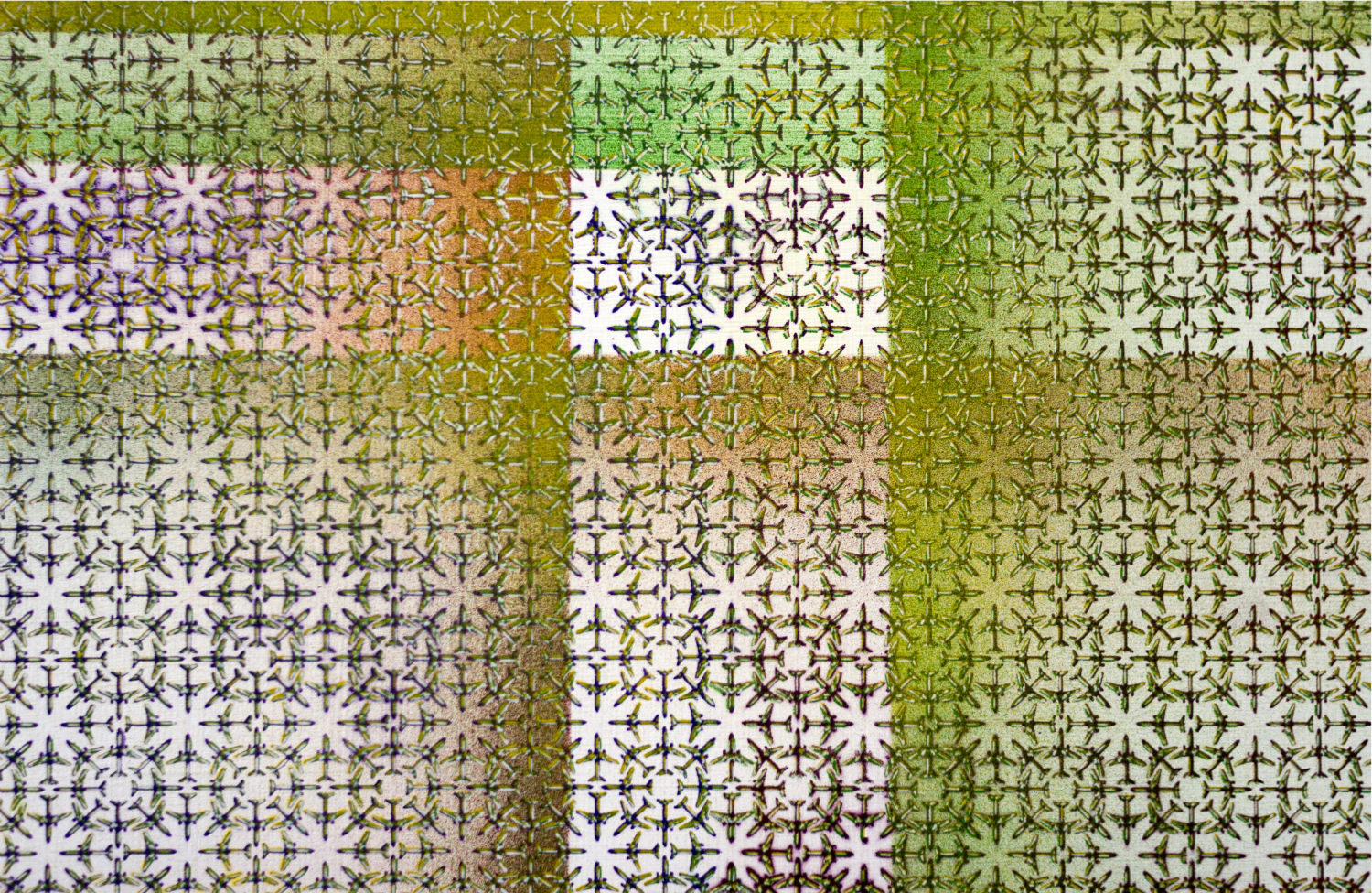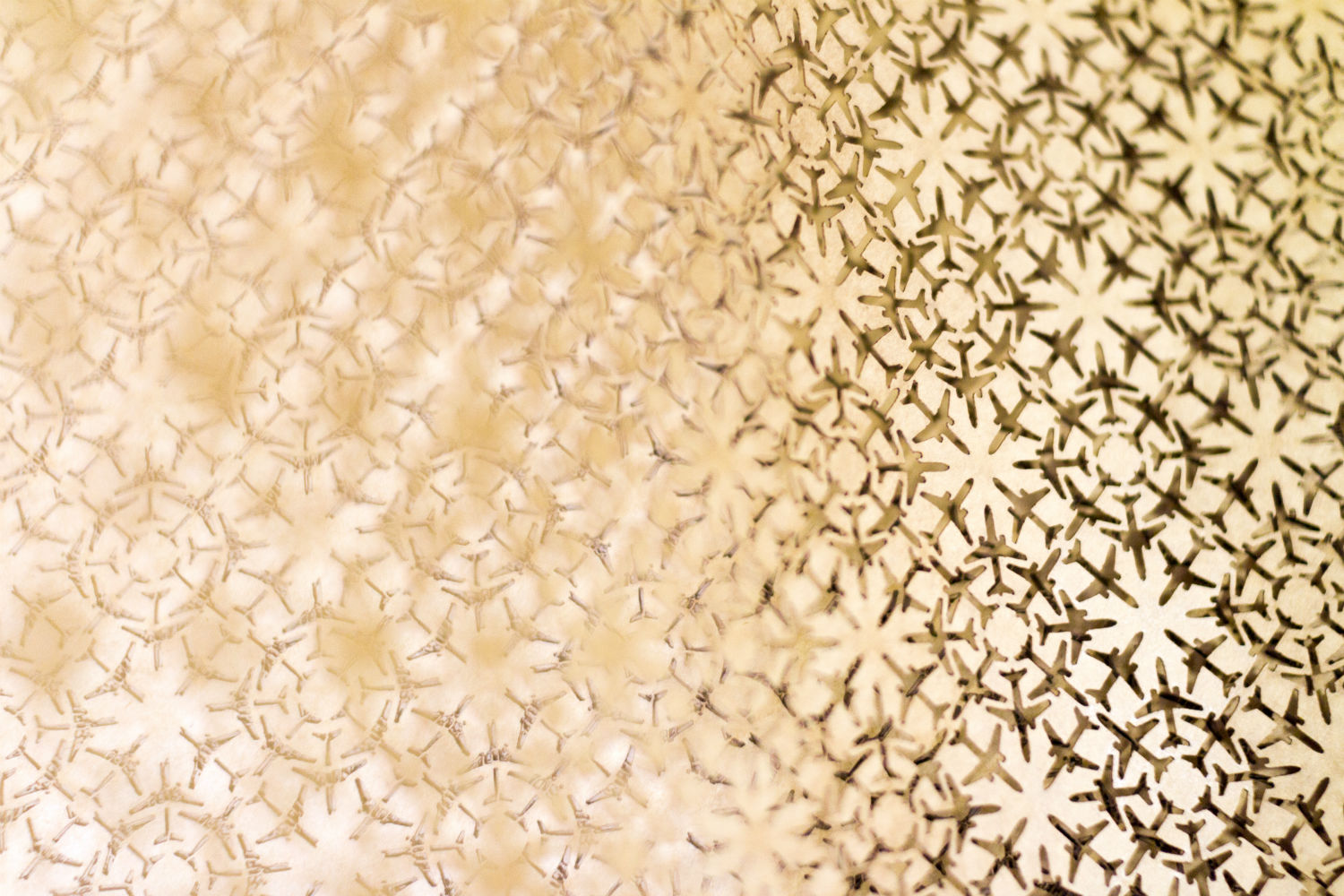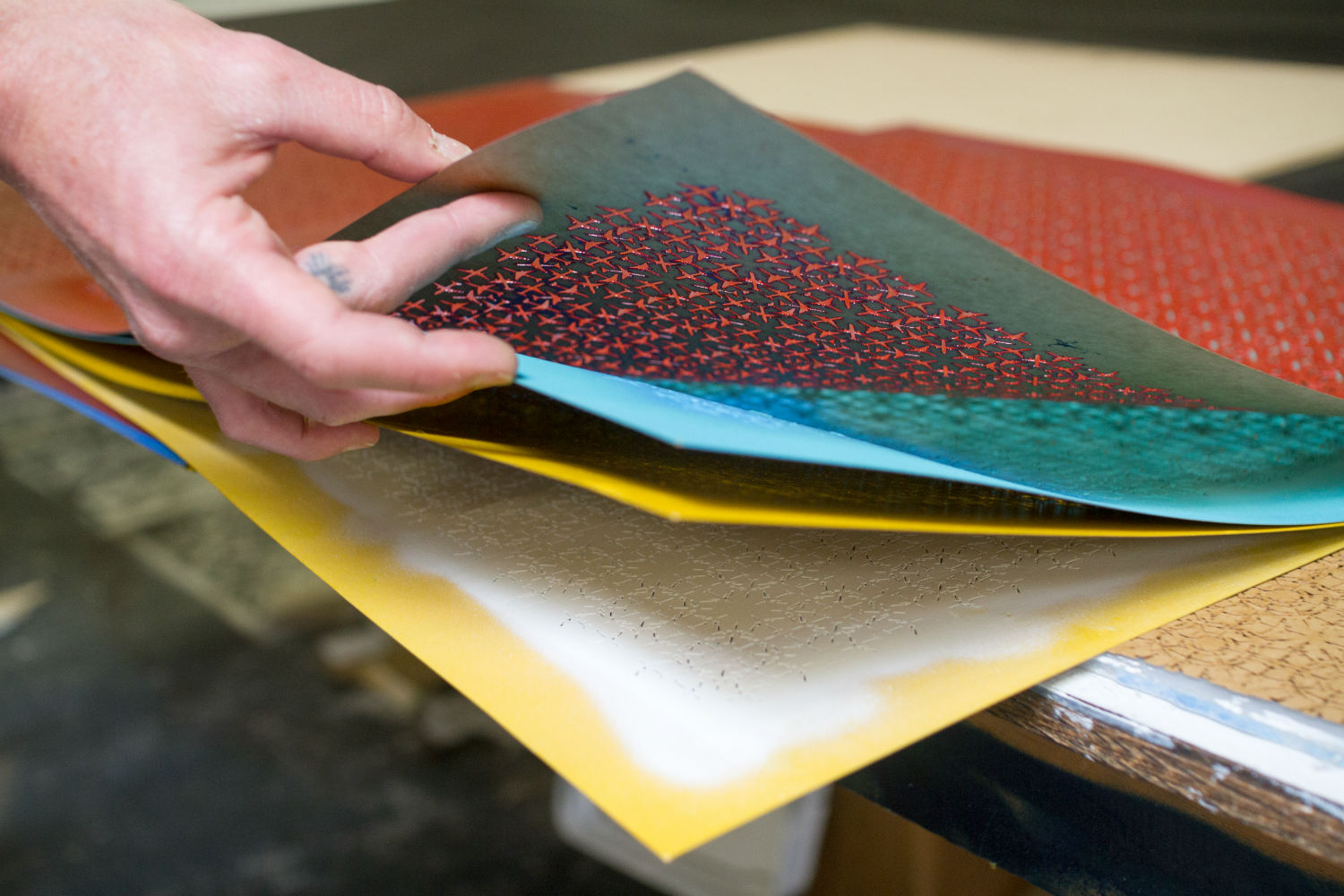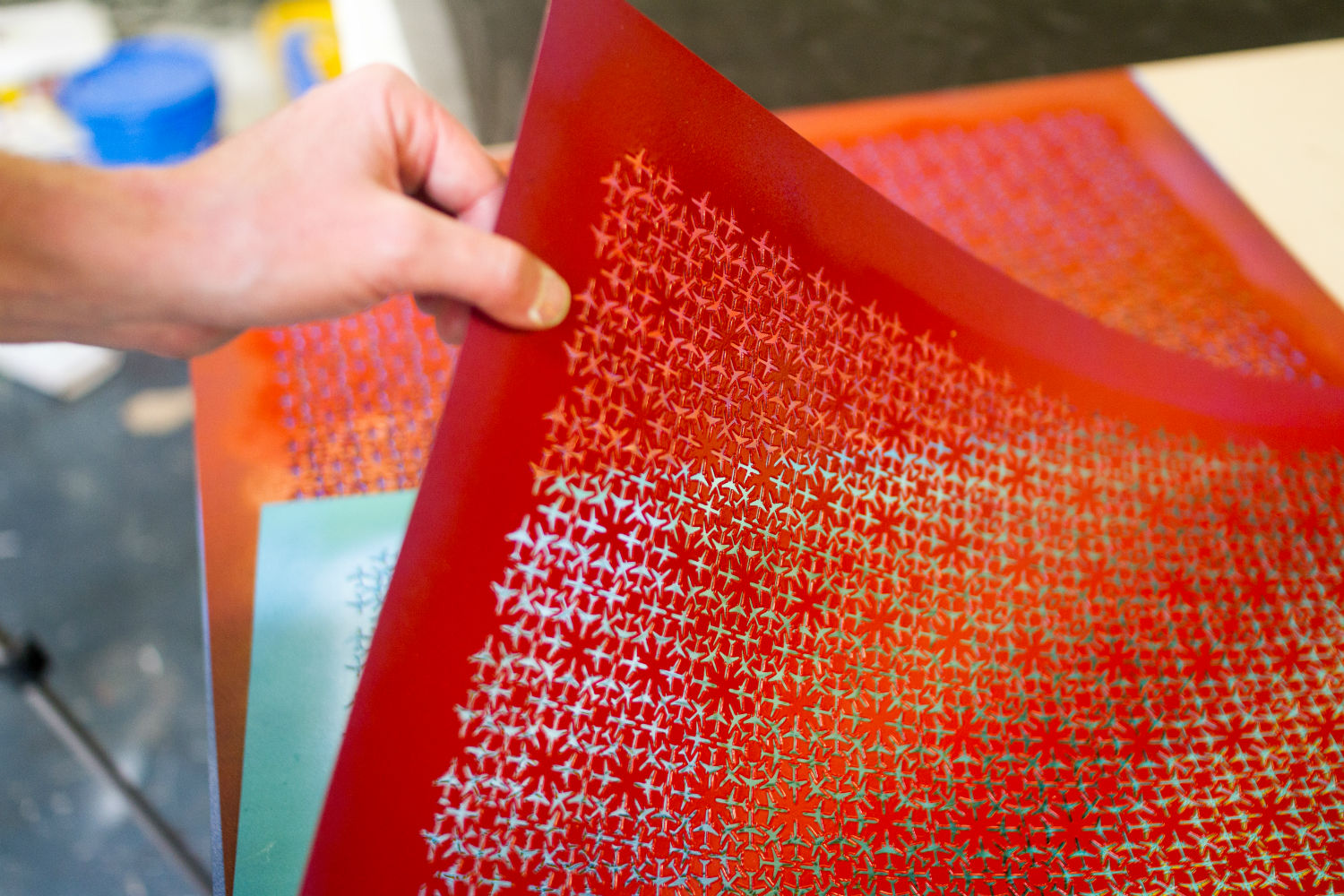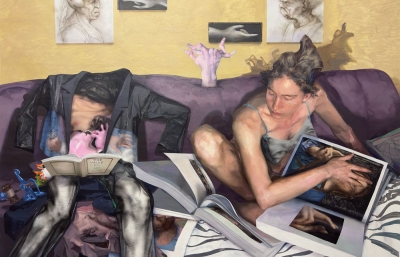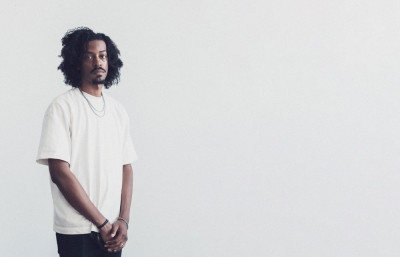
Adam eli feibelman
Personal Provenance
Interview by alex nicholson
Walking into Adam Feibelman’s studio is walking into a mess, a good mess, in that satisfying, artist-at-work kind of way. Surrounded by projects in various states of completion, scattered and stacked on every available surface, I was careful to avoid toppling the very large vase precariously filled to the brim with used X-Acto blades. On one visit, a bicycle wheel sat on a ladder in front of an old projector as Adam demonstrated how the shadows moved through the different patterns he cuts out. A few weeks later, I strolled in to find him making a silicone replica of the leg of the Hungarian camerawoman caught on film, tripping and kicking fleeing Syrian refugees. “The idea for a piece will come up, and for the most part, I’m able to execute it then and there,” he tells me. “I think it’s why I naturally gravitated towards art, but it took some time to figure out which ideas were worth pursuing.” While the stencil work is what Adam is most known for, his practice continually evolves in order to realize each new idea. The last time I stopped by, he took me through all the work for his upcoming exhibition, explaining how each piece inspires or was inspired by another. Personal Provenance, Adam’s first “straight-up conceptual show,” will address various topics related to migration, asking viewers to consider their own family’s journeys as they make their way through the space.
Alex Nicholson: What was your house like growing up? Were your parents creative people?
Adam Feibelman: My dad is a scientist and my mom was a fundraiser for a nonprofit. I would say that it was creative in that my parents are both stimulated by art, had art around and made a point of making sure my sister and I went to museums a lot. I think I caught on pretty early that my imagination and hands were connected. And my dad being a scientist, that’s actually a pretty creative thing.
What kind of science?
Physicist, surface science, which is the study of how molecules move on surfaces of materials. It can be applied to all kinds of things from waterproofing to friction and adhesives. My parents met in an opera group. They're very well-rounded people, I would say. They've got their hands in everything.

Do you recall the first moment, beyond coloring and making things as a kid, where you thought, "Oh, I think want to spend my life doing this."
You know, I don't know if I had that realization until I was way older. Actually, when I was a kid, I said I wanted to be a cartoonist or an architect.
Well, that's pretty close.
Yeah, for sure. But as I progressed through the Albuquerque Public Schools, I didn't really see a future in either one of those, even though I had been kind of making artwork since I was a kid. My parents were really good at making sure I was in art classes. When I was really young, I wanted to draw Garfield and Calvin and Hobbes. There's stuff at my parents' house they still have that I made when I was eight years old that I would own now as contemporary artwork [laughs]. One of them was a foam core replica of breakfast. It was a placemat with a napkin, a fork, a knife and a plate with eggs and bacon and toast on it. The placemat had a pattern, and they still have it. When I see it, I think, “Wow, whatever little kid made this was pretty good!” It wasn't until nearly failing in high school that my mom suggested maybe I should think about going to art school. That ended up being the way to go.
Did you get into graffiti in high school or in art school?
In high school I was much more into graffiti.
That's when the stenciling came in?
I would say, in high school, I was more of the character guy. I could do faces much better than I could do letters. But then again, Albuquerque had kind of a gnarly gang-associated graffiti world and there was a lot of machismo bullshit going around. When I had the opportunity to leave, I decided I would leave all of that behind as well, because I had nothing to prove. I still have nothing to prove... I think. Maybe I do. Maybe I'm proving it right now.
I was first exposed to stenciling in high school. I forget who it was who had cut a stencil of a troll leaning against a tree. I thought it was really great. That's the first time I cut stencils, I was kind of trying to copy this other dude. Then I went off to art school and got steeped in all kinds of traditional techniques, painting, and then mostly printmaking. Then, when school was wrapping up, I realized that I wouldn't have a print shop to work in anymore, and that was one of the things that I knew how to do best. But I also knew how to fade and use spray paint and mix colors, and I knew how to do color separations from studying printmaking. I'd been studying some woodblock printing so when I couldn't do the woodblocks anymore, I started cutting them out of paper. Then I started wanting more from the single layer paper cuts. That's when I started adding colors and making new friends who were into cutting stencils and learning from each other. There's an old website called Stencil Revolution.
I remember that site! I spent some time on it back in the day.
Yeah, there was a community of people on there pushing each other forward. Then I started thinking about the stencils themselves as the artwork, rather than the actual paintings.
What triggered that?
It was a realization that the direction I saw street art and graffiti going was too simplistic because my interests were someplace else. I feel like street art was trying to make a point to a big population, whereas I wanted to talk to myself and have a one-on-one conversation with people. There's more of a process of discovery, seeing how far you can push your own personal limitations, how long you can stick with something, and how focus can influence that. I made this conscious effort to turn my stuff a little bit more experimental. Going back to the discussion about my dad, it comes from the desire to always have wanted to work in some sort of science.
What specifically did you want to experiment with?
I find that there are a lot of different starting points when it comes to my artwork. Throughout the process, there are jumping off places and tangents that I could follow. At the very start, the single layer pieces eventually evolved into the intense patterns. When making the printmaking-style work, although designed to end up making my paintings, people would look at them and ask why I was having photographs digitally printed on wood. I realized that I needed to expose the process more and not simply discard the byproducts, actually use the tools themselves as a frame for what I was trying to do. So I started making the sewn paper assemblages that have now morphed to where the paper stencils can exist in a much more simplistic way.
And there are tangents that shoot off from there. I now can experiment with the different materials and papers. I'll use different materials to make stencils, but then those materials echo back into the work and reignite my desire to make the paintings. It's this self-sufficient cycle of stuff, of process. Now it's pressing into more conceptual things where, instead of wanting to discuss things on a personal level or on a one-on-one basis with a viewer, I want to talk about bigger issues.
Who do you find yourself most often trying to communicate with?
Each one of the styles has a different impetus. The patterns are me trying to be as precise as possible and are kind of an experiment. The cityscapes and paper assemblages would be trying to communicate a very personal take on my environment and the times we live in. A lot of effective art over the centuries has been people who document their times. I wanted to do that for a while, documenting changes that happen within the city. All cities change, they ebb and flow. Things get torn down. Things get built back up. Documenting that is important to me, but now I feel like talking about something else, so I'm learning new modes of communication. I need to add my voice to bigger, broader social issues that are going on in the world. And that has come from doing three years of commissions. When you're dealing with other people’s ideas, you really have to take into consideration a broader understanding of what you're trying to get across—the absolute necessity of getting the piece of artwork to that point where it's communicating a pretty heavy idea to a broader audience.
For the planes, when people are walking around in their everyday life, they don't consider the magic of this web of ability to travel around the world in its true scale. When you think about flying, you think about it in a very modular sense. You're in this airplane with 230 other people. You were just at an airport where there were thousands of other people flying out in other directions, but really, you're only thinking about it on your scale. I wanted to make this painting that encompasses the enormity of the magic carpet that gives us all the capability of flying at any given moment, this web of human achievement where every day there are 102,465 flights in the world. If you can gather the money, you can get on any one of those flights. What happens when you get on the other side of a border is a totally different situation, but for the most part, as Americans, we can travel wherever we want. Every year, there's six billion people who travel by airplane. I wanted this pattern and piece to show that scale to an individual viewer. When I stand next to it, I feel dumbfounded by how many planes there are in that piece.
Speaking of broader issues, your upcoming exhibition at Guerrero Gallery will focus on migration and immigration. Tell me about some of that work.
One of the pieces I’m making for the show is 100,000 planes on a 12-foot square canvas. I wanted to talk about the non-existence of borders. Another piece is a replica of the world's most expensive rug. The rug, which sold in 2013 for 34 million, has traveled around through time and space, collected and curated and kept safe for all these generations. It has been able to jump borders without any of the problems that a person would have. In fact, it's been desired and hugged more closely, while actual living human beings coming from the Middle East, specifically Syria, are shunned and kept at an arm's length. They are treated as valueless, and borders are impassable.
That's different from my other work, because it really is talking about the numbers as a very specific idea rather than an emotional response. Most immigrants who are here illegally don't come here by crossing over a border; they fly here and overstay their visas. All the people who are hell-bent against immigration have completely forgotten how their families got here. It's not necessarily taking a political standpoint in this show, but just asking people to reconsider their own journeys.
102,465 is a lot of planes to cut out.
Mathematically, the only way to get the maximum amount of planes into two square inches is this pattern, which, as it turns out, references all kinds of stuff from the Alhambra to Mexican tile work. I'm working with my buddy Andrew to make 2-foot square stencils that have 4,000 planes in each one because despite the impossibility of cutting out 100,000 planes, it's not about the process in this piece, it’s an infographic. I want people to feel the magnitude of the network that humanity has built around the world. There's something like 700,000 people in the air at any given time. The idea that there are all these people living in the sky is fucking crazy.
Insane. And what affect does that many planes in the air have on the planet?
Then there's the whole climate change aspect to it, right? They’re implanting pollution directly into a layer of earth where we don't need pollution. There's going to be another piece in the show that is actually sitting up on top of one of my shelves. It's just a black piece of paper with a stencil on it that says “waterlogged.” It's been gathering dust for nine months, so when you take the stencil off, it'll just say “waterlogged” in dust. As climate change really takes effect, big cities on the coasts will be forced to vacate while elsewhere others will be fleeing drought. This piece is to get people thinking about those scenarios, and the movement of people.
The climate refugees.
200 million people are going to try to move around the Earth and Trump thinks a little fucking wall is going to keep that many people out. He's fucking out of his mind.
The process of those two pieces has also been different. Why is the rug cut out of screen rather than paper?
I've been looking at screen for a long time because, back in the day, I would use it for spray-painting to do little shades and whatnot. And then I was using it to create patterns and became interested in the idea of moirés. As I was deciding what I was going to cut the rug out of, I thought, "How do I change this rug in a way that takes the ultimate value out of it?" How do I take an image and completely empty it so it's just the image, rather than an actual functional rug. That's where I landed on screen. Working with screen is so tough though, so hard, such a nightmare to cut.
You’ve been doing a lot of these freestyle pattern pieces lately. Where did those come from?
When I was younger, and this goes back to school days, I was diagnosed with a really specific type of dyslexia called scotopic sensitivity. It’s basically just a sensitivity to contrast, to light and dark. When you're reading a page in black and white, the light in the room and the contrast between the pattern of the letters and the whiteness of the page, and even some of the pattern of the letters coming through on the back of the page, make letters vibrate. So, just like most dyslexics, I will read the same sentence over and over again.
How that applies to the pretty intense patterns that I make is that it's almost a game to play with my own dyslexia. I start out and I like to try to keep it as precise, uniform and square as possible. I’ll play with the vibrations in my eyes as much as I can to really activate it. About four or five inches into the piece, all of a sudden, the vibrations start making everything wonky. It's basically playing with my learning disability. They're like maps of my dyslexia.
Nothing is perfect. The only things that are perfect in this world are made by computers. I find that the patterns have a lot of relationship with the dynamics of nature, or when the fetus is formed, the DNA is instructing specific cells to replicate in a very specific way. All it takes is one little nudge and all of a sudden, that one little nudge has grown into something else. That's why we have different shapes of trees. That's why no snowflake is alike. The same with humanity. This is why each one of us is special in our own little way, our cells splitting at their instructed place.
No matter what I do, I'll never be able to cut the same pattern twice. I'm fascinated by that idea. As I'm working on them and getting into them more, a lot of times I'm thinking about the other projects I have going on as well. The great thing about the paper cutting process is that you have the luxury of time to figure out problems conceptually that can then be turned into practice, a solid vision of how to get through. Then, as you're applying that process to the next thing you're working on, something else is developing for other work. Again, it's just like a big cycle of... trash. That's why the studio is such a chaotic mess.
You need that time, that boredom, for ideas to grow.
The most luxurious thing in this entire world, or the most expensive thing in this whole world, is time. I don't know if that's a famous quote, or if I said that, but that's the real thing. If you can have that luxury of time, and the will to make something, that's the most expensive thing in the world.
How does something, like the piece with the dots representing the ideal size of a village, evolve from a thought into a piece of art?
Plato had this theory that the perfect size for a town or village was 5,040. It’s a magical number that's divisible by all the numbers between one and ten. He came up with this idea that in order for ten people to be satiated with water, they would need one fountain, one baker, one blacksmith, etc. He separated them into these perfect little squares of people. Some of the first urban planners were reading Plato to decide on how they should design a city, and apparently some of the most perfect cities in the world are in Serbia built on Platonian ideas.
The name of the piece is called 5,041 Too Many. That's the one little fucker on the other side of the wall trying to get in. How could you come up with this super idealistic idea of manufacturing a civilization that's going to be this perfect number and not take into consideration that there's going to be a lot of other people who might want in, you know? This piece was kind of an accident; I was just doing it as a doodle.

What else is going to be in the show?
My grandfather's own immigration coat is going in the show. It's a thirty-pound iron wool overcoat. The thing is insane. You put it on and you think it’s not so bad and five minutes later you're, like, “Gasp, gasp.”
So that’s why the masses were so tired and huddled... what is iron wool?
Haha. It's a particular blend of wool that is extremely heavy and dense. You get the idea that instead of bringing a blanket, this jacket would be all encompassing. It was your sleeping bag; it was you're everything. You're on this boat in the middle of the fucking ocean in the middle of wintertime, and if you didn't have a coat to fucking sustain your life, you'd be dead, dead as a doornail.
Every time I’ve come by your studio, you have an entirely new idea you’re running with.
Yeah, every time something seems like it's getting a little bit stale, something happens that pushes it forward six notches, and I can't help but be back into it. The art studio practice has to be like a tree. It has to have roots that are constantly growing, it has to have a trunk with healthy bark and branches that are strong, and it has to be producing its fruit and seeds. I think the conceptual stuff is the tree, and it has finally grown to the point where the fruit is ripe, and we're about to see what that fruit tastes like. The ecosystem has to be running on all cylinders because if it weren't for the stencil work, the pattern pieces and the multilayer things, I would never be at the place that I am right now. Never.
The other day, I read an interview with Richard Serra, who was saying to just close your eyes and keep doing your own thing. Don't pay attention to what's going on in the art world, do your own thing. I feel like that is super good advice.
That is good advice, or at least comforting advice. It’s something you want to hear.
Success is such a weird thing. I thought I had figured it out the other day. I had cast these bones in resin after being told that it was impossible, and one of them turned out. I thought, "That's success in art. Not listening to all the fucking bullshit going on and doing the best you can.” If there is a point where you're pretty happy, that's the pinnacle of success in art. If I sell those two pieces, they're gone; I'm not going to feel success. I will take my money and pay my rent and eat some food and then forget that those days even existed.

